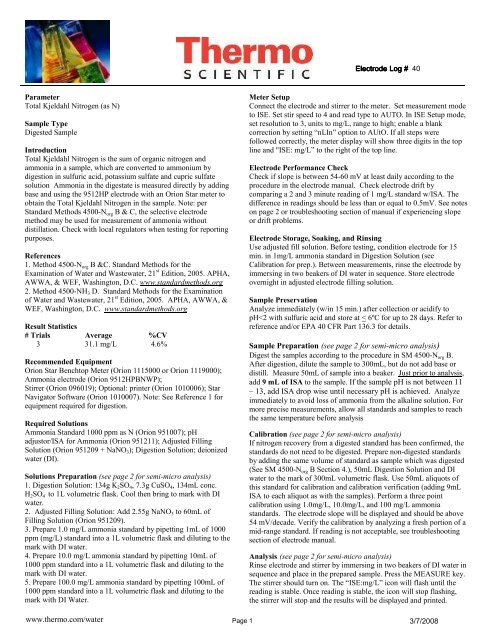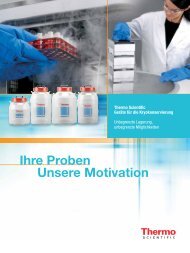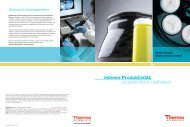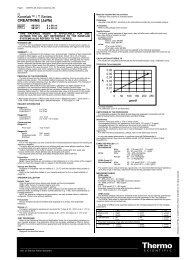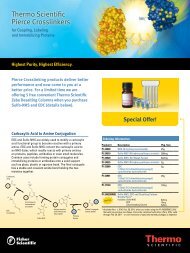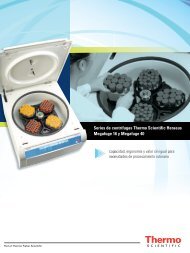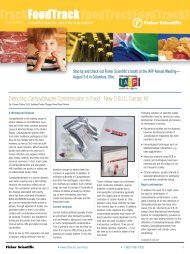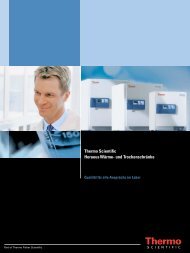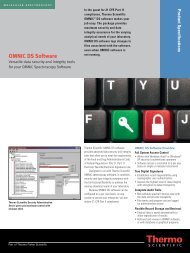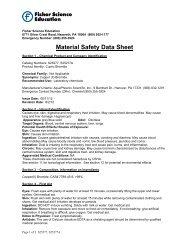Kjeldahl Nitrogen in Digested Sample
Kjeldahl Nitrogen in Digested Sample
Kjeldahl Nitrogen in Digested Sample
You also want an ePaper? Increase the reach of your titles
YUMPU automatically turns print PDFs into web optimized ePapers that Google loves.
Parameter<br />
Total <strong>Kjeldahl</strong> <strong>Nitrogen</strong> (as N)<br />
<strong>Sample</strong> Type<br />
<strong>Digested</strong> <strong>Sample</strong><br />
Introduction<br />
Total <strong>Kjeldahl</strong> <strong>Nitrogen</strong> is the sum of organic nitrogen and<br />
ammonia <strong>in</strong> a sample, which are converted to ammonium by<br />
digestion <strong>in</strong> sulfuric acid, potassium sulfate and cupric sulfate<br />
solution Ammonia <strong>in</strong> the digestate is measured directly by add<strong>in</strong>g<br />
base and us<strong>in</strong>g the 9512HP electrode with an Orion Star meter to<br />
obta<strong>in</strong> the Total <strong>Kjeldahl</strong> <strong>Nitrogen</strong> <strong>in</strong> the sample. Note: per<br />
Standard Methods 4500-N org B & C, the selective electrode<br />
method may be used for measurement of ammonia without<br />
distillation. Check with local regulators when test<strong>in</strong>g for report<strong>in</strong>g<br />
purposes.<br />
References<br />
1. Method 4500-N org B &C. Standard Methods for the<br />
Exam<strong>in</strong>ation of Water and Wastewater, 21 st Edition, 2005. APHA,<br />
AWWA, & WEF, Wash<strong>in</strong>gton, D.C. www.standardmethods.org<br />
2. Method 4500-NH 3 D. Standard Methods for the Exam<strong>in</strong>ation<br />
of Water and Wastewater, 21 st Edition, 2005. APHA, AWWA, &<br />
WEF, Wash<strong>in</strong>gton, D.C. www.standardmethods.org<br />
Result Statistics<br />
# Trials Average %CV<br />
3 31.1 mg/L 4.6%<br />
Recommended Equipment<br />
Orion Star Benchtop Meter (Orion 1115000 or Orion 1119000);<br />
Ammonia electrode (Orion 9512HPBNWP);<br />
Stirrer (Orion 096019); Optional: pr<strong>in</strong>ter (Orion 1010006); Star<br />
Navigator Software (Orion 1010007). Note: See Reference 1 for<br />
equipment required for digestion.<br />
Required Solutions<br />
Ammonia Standard 1000 ppm as N (Orion 951007); pH<br />
adjustor/ISA for Ammonia (Orion 951211); Adjusted Fill<strong>in</strong>g<br />
Solution (Orion 951209 + NaNO 3); Digestion Solution; deionized<br />
water (DI).<br />
Solutions Preparation (see page 2 for semi-micro analysis)<br />
1. Digestion Solution: 134g K 2SO 4, 7.3g CuSO 4, 134mL conc.<br />
H 2SO 4 to 1L volumetric flask. Cool then br<strong>in</strong>g to mark with DI<br />
water.<br />
2. Adjusted Fill<strong>in</strong>g Solution: Add 2.55g NaNO 3 to 60mL of<br />
Fill<strong>in</strong>g Solution (Orion 951209).<br />
3. Prepare 1.0 mg/L ammonia standard by pipett<strong>in</strong>g 1mL of 1000<br />
ppm (mg/L) standard <strong>in</strong>to a 1L volumetric flask and dilut<strong>in</strong>g to the<br />
mark with DI water.<br />
4. Prepare 10.0 mg/L ammonia standard by pipett<strong>in</strong>g 10mL of<br />
1000 ppm standard <strong>in</strong>to a 1L volumetric flask and dilut<strong>in</strong>g to the<br />
mark with DI water.<br />
5. Prepare 100.0 mg/L ammonia standard by pipett<strong>in</strong>g 100mL of<br />
1000 ppm standard <strong>in</strong>to a 1L volumetric flask and dilut<strong>in</strong>g to the<br />
mark with DI Water.<br />
www.thermo.com/water<br />
Electrode Electrode Electrode Log Log Log # # 40<br />
Meter Setup<br />
Connect the electrode and stirrer to the meter. Set measurement mode<br />
to ISE. Set stir speed to 4 and read type to AUTO. In ISE Setup mode,<br />
set resolution to 3, units to mg/L, range to high; enable a blank<br />
correction by sett<strong>in</strong>g “nLIn” option to AUtO. If all steps were<br />
followed correctly, the meter display will show three digits <strong>in</strong> the top<br />
l<strong>in</strong>e and "ISE: mg/L” to the right of the top l<strong>in</strong>e.<br />
Electrode Performance Check<br />
Check if slope is between 54-60 mV at least daily accord<strong>in</strong>g to the<br />
procedure <strong>in</strong> the electrode manual. Check electrode drift by<br />
compar<strong>in</strong>g a 2 and 3 m<strong>in</strong>ute read<strong>in</strong>g of 1 mg/L standard w/ISA. The<br />
difference <strong>in</strong> read<strong>in</strong>gs should be less than or equal to 0.5mV. See notes<br />
on page 2 or troubleshoot<strong>in</strong>g section of manual if experienc<strong>in</strong>g slope<br />
or drift problems.<br />
Electrode Storage, Soak<strong>in</strong>g, and R<strong>in</strong>s<strong>in</strong>g<br />
Use adjusted fill solution. Before test<strong>in</strong>g, condition electrode for 15<br />
m<strong>in</strong>. <strong>in</strong> 1mg/L ammonia standard <strong>in</strong> Digestion Solution (see<br />
Calibration for prep.). Between measurements, r<strong>in</strong>se the electrode by<br />
immers<strong>in</strong>g <strong>in</strong> two beakers of DI water <strong>in</strong> sequence. Store electrode<br />
overnight <strong>in</strong> adjusted electrode fill<strong>in</strong>g solution.<br />
<strong>Sample</strong> Preservation<br />
Analyze immediately (w/<strong>in</strong> 15 m<strong>in</strong>.) after collection or acidify to<br />
pH
Ammonia <strong>in</strong> mg/L as<br />
Wastewater <strong>Nitrogen</strong><br />
<strong>Sample</strong> 1 30.4<br />
<strong>Sample</strong> 2 32.7<br />
<strong>Sample</strong> 3 30.1<br />
Mean 31.1<br />
Standard Deviation 1.42<br />
%CV 4.6%<br />
Quality Control (QC)<br />
Recommended QC procedures <strong>in</strong>clude: calibration and calibration<br />
verification, <strong>in</strong>itial demonstration of laboratory capability and<br />
method detection limit determ<strong>in</strong>ation, laboratory control samples<br />
(LCS), method blanks, matrix spikes (MS), sample duplicates,<br />
and <strong>in</strong>dependent reference materials. See references above for<br />
details.<br />
Electrode Electrode Electrode Log Log Log # # 40<br />
Note:<br />
1).With Auto-blank correction activated, slope on<br />
the meter’s display can be higher than the expected<br />
range of -54 and -60mV/decade due to auto-blank<br />
calculation.<br />
2).If sample concentration is outside the calibrated<br />
concentration range, dilute the sample <strong>in</strong>to range<br />
and rerun or run higher calibration standards which<br />
bracket the sample concentration.<br />
3).If the electrode does not give reproducible<br />
results or demonstrates a slow response, do the<br />
follow<strong>in</strong>g: Remove any bubbles on the membrane<br />
surface by tapp<strong>in</strong>g the electrode. If the electrode<br />
performance is not improved, change membrane<br />
and fill<strong>in</strong>g solution, condition <strong>in</strong> 1mg/L standard <strong>in</strong><br />
digestion solution for 15 m<strong>in</strong>utes and re-calibrate<br />
the electrode.<br />
_____________________________________________________________________________________________________<br />
For Semi-Micro Analysis, make the follow<strong>in</strong>g changes to the procedure on page 1:<br />
Solutions Preparation<br />
1. Digestion Solution: 134g K 2SO 4, 7.3g CuSO 4, 134mL conc. H 2SO 4 to 1L volumetric flask. Cool then br<strong>in</strong>g to mark with DI water.<br />
2. Adjusted Fill<strong>in</strong>g Solution: Add 2.55g NaNO 3 to 60mL of Fill<strong>in</strong>g Solution (Orion 951209).<br />
3. Prepare 1.0 mg/L ammonia standard by pipett<strong>in</strong>g 0.5mL of 1000 ppm (mg/L) standard <strong>in</strong>to 83mL of digestion solution <strong>in</strong> a 500mL<br />
volumetric flask and dilut<strong>in</strong>g to the mark with DI water.<br />
4. Prepare 10.0 mg/L ammonia standard by pipett<strong>in</strong>g 5mL of 1000 ppm (mg/L) standard <strong>in</strong>to 83mL of digestion solution <strong>in</strong> a 500mL<br />
volumetric flask and dilut<strong>in</strong>g to the mark with DI water.<br />
5. Prepare 100.0 mg/L ammonia standard by pipett<strong>in</strong>g 50mL of 1000 ppm (mg/L) standard <strong>in</strong>to 83mL of digestion solution <strong>in</strong> a<br />
500mL volumetric flask and dilut<strong>in</strong>g to the mark with DI water.<br />
<strong>Sample</strong> Preparation<br />
Digest the samples accord<strong>in</strong>g to the procedure <strong>in</strong> SM 4500-N org C. After digestion, dilute the sample to 30mL, but do not add base or<br />
distill. Just prior to analysis, add 5.4 mL of ISA to the sample. If the sample pH is not between 11 and 13, add ISA drop wise<br />
until necessary pH is achieved. Analyze immediately to avoid loss of ammonia from the alkal<strong>in</strong>e solution. For more precise<br />
measurements, allow all standards and samples to reach the same temperature before analysis<br />
Calibration<br />
If nitrogen recovery from a digested standard has been confirmed, the standards do not need to be digested. Use 30mL aliquots of<br />
standards for calibration and calibration verification (add<strong>in</strong>g 5.4mL ISA to each aliquot as with the samples). Perform a three po<strong>in</strong>t<br />
calibration us<strong>in</strong>g 1.0mg/L, 10.0mg/L, and 100 mg/L ammonia standards. The electrode slope will be displayed and should be above<br />
54 mV/decade. Verify the calibration by analyz<strong>in</strong>g a fresh portion of a mid-range standard. If read<strong>in</strong>g is not acceptable, see<br />
troubleshoot<strong>in</strong>g section of electrode manual.<br />
Analysis<br />
R<strong>in</strong>se electrode and stirrer by immers<strong>in</strong>g <strong>in</strong> two beakers of DI water <strong>in</strong> sequence and place <strong>in</strong> the prepared sample. Press the<br />
MEASURE key. The stirrer should turn on. The “ISE:mg/L” icon will flash until the read<strong>in</strong>g is stable. Once read<strong>in</strong>g is stable, the<br />
icon will stop flash<strong>in</strong>g, the stirrer will stop and the results will be displayed and pr<strong>in</strong>ted. Multiply the results by the dilution factor to<br />
get concentration of sample.<br />
www.thermo.com/water<br />
Page 2 3/7/2008


